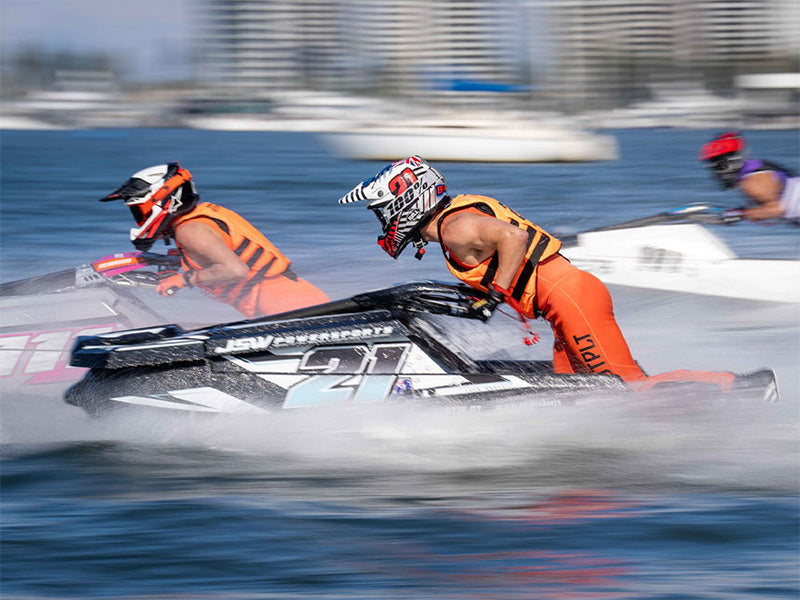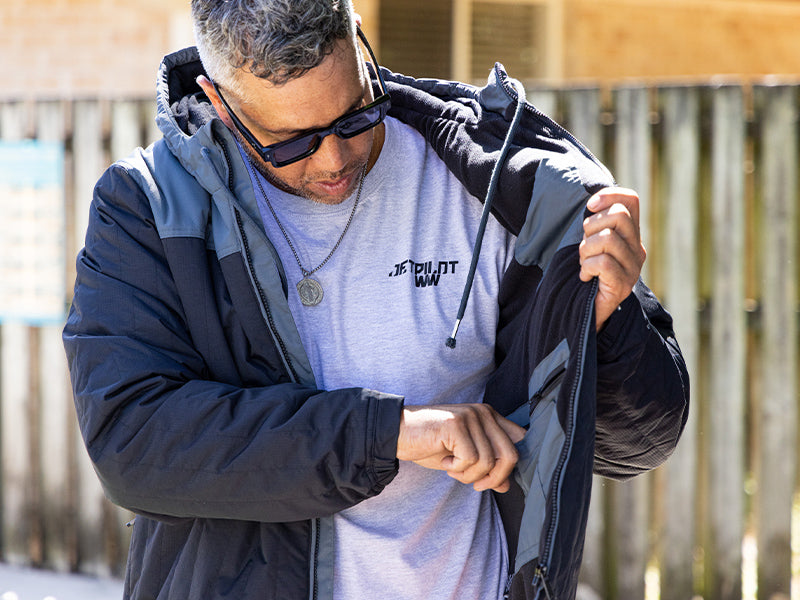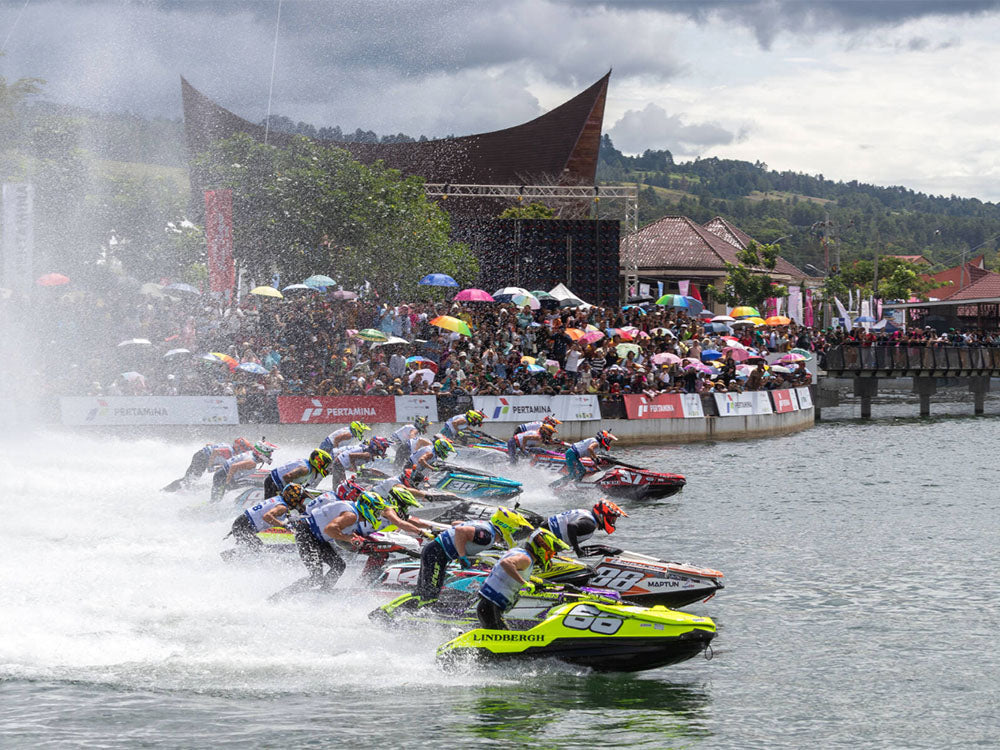If you’ve ever felt the rumble of a high-performance Personal Watercraft (PWC) firing off the start line, you’ll know that this sport isn’t just about speed – it’s a full-blown, sensory overload. Think motocross on steroids, but swap the dusty dirt for the wild, unpredictable waters of Aussie lakes, rivers, and coastlines.
Australia is a premier destination for jetski racing, with the 2025 Australian Watercross Nationals taking place on the iconic Gold Coast, drawing fans and families from across the country.
PWC racing – known by many as Jet Ski racing – is where horsepower meets hardcore, where racers battle it out handlebar-to-handlebar at neck-breaking speeds over 140km/h (yep, you read that right). It’s a chaos of spray, speed and sheer guts. Riders aren’t just steering – they’re wrestling machines through tight buoy turns, launching into the air, and pushing their physical limits every second they’re on the throttle.
While most folks call every PWC a “Jet Ski,” that’s actually just the Kawasaki version. Yamaha’s got the “WaveRunner,” and Sea-Doo’s in there too, but officially, they’re all Personal Watercraft. Doesn’t matter what you call ’em though – if it’s got a jet pump and it flies across water, it’s part of the game.
PWCs are under 12 feet, jet-powered and built to carve, drift, and dominate. And just like motocross, the roots of PWC racing run deep in motorcycle culture – from the gear to the grit it takes to compete.
In this series, we’re diving into everything you need to know about the high-speed world of PWC racing. From the sport’s gnarly history to the global competitions, different racing classes, and the absolute must-have gear – we’ve got it covered. And of course, we’ll be shining a spotlight on Jetpilot’s long-standing connection to the sport – from our first race vests to the tech-packed gear we’re dropping today.
Whether you’re a seasoned racer or just a fan of the fast lane, this is your all-access pass into one of Australia’s most adrenaline-packed watersports. Let’s get stuck in.
Intro to PWC Racing
Personal Watercraft (PWC) racing, also known as jet ski racing, is a heart-pounding, adrenaline-fueled sport that takes high-performance watercraft and pits them against each other on a closed course. It’s not just about speed; it’s about mastering control and precision, making every race a thrilling spectacle.
This sport has been around for decades, gaining popularity worldwide with various classes and events catering to different skill levels and riding styles. Riders push their limits, reaching top speeds that can exceed 60 miles per hour, requiring not just physical but also mental fitness to stay ahead of the competition.
PWC racing is more than just a race; it’s a way to experience the thrill of high speeds and to push one’s limits. It provides a unique opportunity for riders to access new levels of speed and performance, all while navigating the challenges of a closed course. The sport is promoted by organizations like the Australian Jet Sports Boating Association (AJSBA), which ensures that events are organized in a safe and professional manner.
Whether you’re a seasoned rider or a beginner, PWC racing offers an exciting and rewarding experience. It’s a sport that brings together a community of riders who share a passion for speed, competition, and the open water.

From Water Scooter to Racing Beast: The Wild Ride of PWC History
Personal Watercraft (PWC) racing didn’t just burst out of nowhere – it’s been a full-throttle journey of invention, wipeouts, and pure innovation. From humble “aqua scooter” beginnings to the high-horsepower racecraft we see carving up courses today, PWC history is packed with legends, game-changers and plenty of saltwater. These high-performance machines are meticulously engineered for durability and optimal performance, catering to the needs of serious racers and riders.
Born from the Busted Bones of Motocross
It all kicked off in the 1960s thanks to one bloke – Clayton Jacobson II. After stacking his motorbike hard, Jacobson had a brainwave: what if you could get that same motocross buzz, but on water? No gravel rash, just spray in your face and speed at your fingertips.
So he binned his banking gig, moved to Lake Havasu (PWC racing’s spiritual home), and got to work. By ’65, he’d knocked together a working prototype – jet propulsion, upright handle pole, and no exposed propeller. It looked like a stand-up Jet Ski before the world even knew what that meant.

Bombardier Fizzles, Kawasaki Fires
Jacobson first linked up with Bombardier (yep, the Sea-Doo crew), and in 1968 they dropped the Sea-Doo – a sit-down, jet-powered “Aqua Scooter”. But it flopped. Too clunky, too awkward, not enough stoke.
That’s when Kawasaki entered the chat.
By 1973, Kawasaki had rolled out the JS400 Jet Ski – the first commercially successful stand-up PWC. It was sleeker, lighter, and way more fun to ride. Suddenly, the world wanted in. With over 200,000 units sold, the “Jet Ski” name stuck – even though it’s technically a brand name, it became the catch-all for all PWCs.

Enter Yamaha: The Rise of the Sit-Down Runabout
The ‘80s brought a new wave – literally. In 1986, Yamaha launched the WaveRunner 500, a sit-down style PWC (aka “runabout”) that made riding more accessible. You didn’t need to be a lean, mean freestyle machine – mums, dads, and the kids could all hop on and go for a rip.
That move flipped the market. Stand-ups stayed king for racers and freestylers, but runabouts opened the floodgates for casual riders. BRP (Bombardier Recreational Products) a Canadian company known for manufacturing recreational vehicles like Sea-Doo jet skis, Can-Am ATVs, and Ski-Doo snowmobiles, caught on and came back swinging with a new-look Sea-Doo in ’88, and by the mid-90s, they were dominating with over half the global PWC sales.
By now, big names like Honda, Polaris, and Arctic Cat had joined the game – but it was Kawasaki, Yamaha and Sea-Doo leading the charge and shaping how we ride today.
Race Mode: PWC Racing Finds Its Groove
With all these machines ripping around, it was only a matter of time before competition kicked off. Kawasaki, always keen to push limits, helped set up the US Jet Ski Boating Association (USJSBA) in the late ‘70s. The first major race went down in 1977 in Mission Bay, San Diego – think closed course, Le Mans-style starts, ski jumps, and freestyle throwdowns.
Legends like Bob Phares and Steve Stricklin helped mould those early days, testing machines and promoting the sport. As the scene went global and sit-down skis entered the fold, the USJSBA morphed into the International Jet Sports Boating Association (IJSBA) in 1982.
With new categories like Sport Class (thanks to models like the Kawasaki 650 X2), the groundwork was laid for the legit, structured sport we know today – where technical skill, custom mods, and raw speed meet in a spray-soaked battleground.
The Arena: Where Jet Ski Racers Push Limits and Battle the Elements
If you thought PWC racing was just about gunning it in a straight line – mate, think again. This sport’s got layers. Whether you're dodging buoys on a closed course, charging across offshore swell, or pulling off a backflip in front of a roaring crowd, there's a racing style for every type of water junkie out there.
Let’s break down the main Jet Ski racing disciplines and the big dogs who run the show.
The Rule Makers: Who’s Running the Show?
Just like motocross or V8s, Jet Ski racing has its own global and local governing bodies that make sure everything runs smooth and legit. These organizations provide essential information about jetski racing, including classes, equipment, and costs.
- IJSBA (International Jet Sports Boating Association): The big kahuna of PWC racing. These legends set the global rulebook, run the famous World Finals at Lake Havasu, and keep things fair across over 50 countries. If you’re getting serious, you’ll need an IJSBA membership to jump in.
- UIM (Union Internationale Motonautique): Recognised by the IOC and overseeing all things powerboating, UIM runs the slick UIM-ABP Aquabike World Championship – top-level stuff for endurance warriors and offshore grinders.
- Pro Watercross (PWX): One of the big players in the USA, PWX is all about closed-course action and epic freestyle comps. They’re known for keeping it fresh with things like the Triple Crown format and light-based start systems.
- P1 AquaX: Born in the UK and tearing it up globally, AquaX makes racing more accessible with endurance-based formats that suit weekend warriors and up-and-coming talent alike.
Yeah, the scene can get a bit hectic with all the different bodies and rulebooks, but that’s part of the ride.

Closed Course: High-Speed Chaos in Tight Quarters
This is where Jet Ski racing really feels like motocross on water. You’ve got 10–12 riders blasting off the line, wrestling their skis around a tight buoy course at full tilt. Red buoys mean left, yellow means right, and if you miss one? You’ll be taking the scenic route around the penalty buoy.
Courses are usually 800–1300m long with multiple laps. Speeds can crack 140km/h, and the starts are just as wild – from full sprint Le Mans-style to rolling or dead-engine starts, depending on who’s running the show. The power and performance capabilities of these jetskis are on full display, with high horsepower engines and agile handling making for an exhilarating racing experience.
This is the most popular format for a reason – it’s chaos, it’s close quarters, and it’s the perfect blend of skill and guts.
Endurance & Offshore: Where Legends Are Built
Got stamina for days? These formats separate the casuals from the hardcore.
Jet Ski riding and racing activities are year-round, promoting community engagement and excitement for all skill levels.
- Endurance Racing: Long circuits or point-to-point routes that test your physical and mental game. Races can last hours, so you’ll need strategy, fuel smarts, and a PWC that won’t tap out early. Events like the Mark Hahn 300 are straight-up marathons on water.
- Offshore Racing: Imagine charging through open ocean swell for 110+ km – that’s Offshore. It’s wild, unpredictable, and tough on both rider and machine. Navigation, fitness, and proper prep are key. It’s often called a “bike, body and bone breaker”, and that’s no exaggeration.

Freestyle & Freeride: Tricks, Waves & Total Mayhem
This is where PWC meets action sports. It’s not about who’s fastest – it’s about who can blow minds.
- Freestyle Jet Ski Tricks: Backflips, barrel rolls, subs, and even Superman-style aerials – all packed into a 2–3 minute routine. Judges rate you on style, difficulty, and flow. You’ll need next-level core strength and creativity to win here.
- Freeride: Less comp, more surf-style. Riders head into the ocean to launch off waves, carve hard, and just send it for the love of it. It’s big in the culture and Jetpilot has been right in the thick of it – running events and backing Freeride since day one.
Other Racing Styles Worth a Shout
- Slalom: Timed zig-zag sprints around markers. It’s all about control and clean lines.
- Drag/Hydrodrags: Straight-line, flat-out acceleration battles – blink and you’ll miss it.
- Jet Raid: Multi-day, multi-stage endurance epics with land crossings and long hauls. Pure adventure.
- Special Events: Think obstacle courses in mega pools or river races through town centres. Wild formats, max entertainment.
From high-speed circuit battles to jaw-dropping tricks and offshore grinds, PWC racing’s got something for every kind of water nut. Whether you're a racer, spectator or weekend warrior dreaming of lining up on the grid – there’s a place for you in the pack.
Where Legends Are Forged: The Biggest Jet Ski Comps on the Planet
If you reckon local lake runs or weekend meet-ups are where PWC riders test their mettle, wait till you catch the global stage. Across the world, the PWC racing calendar is packed with high-stakes events where the best riders come to throw down and claim bragging rights.
These aren’t your average backyard races – these are the big leagues. From the sun-scorched shores of Arizona to the sparkling surf of Portugal, these events are where Jet Ski champions are made.
The IJSBA World Finals – The Mount Everest of Jet Ski Racing
Held every October in Lake Havasu City, Arizona – where PWC racing basically began – the IJSBA World Finals is the most iconic event in the game. This isn’t just any comp; it’s the heart and soul of the sport.
More than 750 riders from over 30+ countries hit the water at Crazy Horse Campground to fight for a world title. Every class is covered – Pro, Amateur, Women’s, Juniors, Vets, Vintage skis, and of course, the heavy-hitting Freestyle comps that always turn heads.
To even line up at this one, you’ve gotta earn your stripes at national or regional qualifiers. It’s invite-only, so you know the standard is elite. Outside the racing, there’s a massive PWC trade show and the biggest global meet-up of riders, tech heads, and brands you’ll ever see. If you’re into the culture, this is your Mecca.
UIM-ABP Aquabike World Championship – PWC Racing Goes Global
Backed by the Union Internationale Motonautique (UIM) – the same crew recognised by the International Olympic Committee – the Aquabike World Championship is the premier international Jet Ski racing series. It’s been turning heads since the '90s, now run by H2O Racing.
The series stops all over – Italy, Saudi Arabia, Croatia, China – with events stacked with Runabout GP1, Ski GP1, Ski Ladies GP1, and Freestyle divisions. You’ll catch top names like Kevin Reiterer, Emma-Nellie Ortendahl, and Rashid Al-Mulla throwing it down here.
There’s often crossover with IJSBA racers, which makes for a bit of a rivalry over who’s the real world champ – but hey, more action for the fans!

USA Showdown: The Pro Watercross Tour
Over in the States, Pro Watercross runs the national scene with a style all its own. It’s got over 30 years of history and used to criss-cross the country, but these days it’s more dialled in, with their Triple Crown format keeping it tight – mostly racing through Florida and Georgia.
They host a proper World Championship too, usually in Naples, Florida. Their format is big on Closed Course battles and Freestyle, with events now being shown on CBS Sports, so fans can catch the chaos from the couch.
They’ve also ditched the old-school rubber band starts in favour of high-tech light systems – it’s a slick, spectator-friendly show that still keeps its grassroots feel.
AquaX – Racing for the Everyday Thrill Seeker
Want to race without having to sell the ute or fly halfway across the world? That’s where P1 AquaX comes in. Born in the UK and now huge in the States, AquaX is all about accessible Jet Ski racing – especially if you’re running a sit-down (Runabout) ski and keen on longer formats.
Think endurance racing on coastal courses, with events all around Florida – Clearwater, St. Pete, and even inland like Kissimmee. Their tiered horsepower classes (200, 250, 300hp) make it easy to find your level, and there’s room for both Pro/Elite riders and weekend warriors.
You’ll need an IJSBA membership to race, but for those chasing the thrill without needing to trick out a race ski to the nines, AquaX is the perfect launch pad.
From elite showdowns like the IJSBA World Finals to grassroots-to-pro events like AquaX, there’s no shortage of action in the global Jet Ski scene. Whether you’re eyeing the podium or just keen to join the pits and soak up the stoke, these comps show exactly why PWC racing continues to grow – more speed, more style, and more people living for life on the water.
The Racer’s Toolkit: What You Need to Compete in Jet Ski Racing
It’s no secret that Jet Ski racing is as much about having the right kit as it is about skill on the throttle. From the type of watercraft you choose to the mods you’re allowed and the safety gear that keeps you protected – getting geared up right is key to getting on the podium (or just surviving your first few laps!).
Let’s break down everything a serious rider needs to know before hitting the start line. Products are meticulously engineered for durability and performance, ensuring that every piece of gear can withstand the rigors of high-speed racing and provide optimal safety and efficiency.

Pick Your Ride: Stand-up vs. Sit-down
Your first big choice? Deciding between a Stand-up (Ski) and a Sit-down (Runabout). Each has its vibe – and your decision will shape your racing path.
- Stand-up (Ski): Think agility, freestyle flair, and full-body fitness. These are lighter, super nimble and built for those who like to throw down on tight turns or in freestyle comps. If you’re racing in Ski GP or pulling off flips, this is your weapon of choice.
- Sit-down (Runabout): More grunt, more stability, and more suited for high-speed courses and long-haul endurance races. These beasts – like the Sea-Doo RXP-X or Yamaha GP1800R – are the go-to for Runabout GP and Offshore classes.
Understand Your Class: Stock, Limited, GP/Open
Racing isn’t just about what you ride – it’s about how much you’re allowed to tweak it. Here’s the lowdown on the main PWC modification classes:
|
Feature |
Stock Class |
Limited Class |
GP / Open / Modified Class |
|
Engine Internals |
Strictly Stock / Minor repairs & boring allowed |
Moderate mods allowed (e.g., cams, valves) |
Extensive mods / Aftermarket allowed |
|
ECU / Ignition |
Stock hardware / Reprogramming allowed |
Aftermarket allowed |
Aftermarket allowed |
|
Exhaust System |
Strictly Stock / Minor mods (e.g., resonator) |
Moderate mods allowed (e.g., pipes, restricted box) |
Extensive mods / Aftermarket / Through-hull allowed |
|
Hull / Deck |
Strictly Stock |
Strictly Stock |
Aftermarket allowed (often requires homologation) |
|
Pump Assembly |
Stock housing / Aftermarket impeller allowed |
Aftermarket allowed (potential restrictions) |
Aftermarket allowed |
|
Handling Components |
Aftermarket allowed (Sponsons, Grate, Plate) |
Aftermarket allowed |
Aftermarket allowed |
|
Forced Induction |
OEM System Only |
OEM System / Potential impeller change |
Aftermarket / Add-on allowed (subject to rules) |
|
Overall Philosophy |
Low cost, near-showroom, handling focus |
Mid-level performance mods, controlled cost |
Maximum performance, encourages development |
Bottom line? Stock class is perfect for rookies and budget-conscious riders. Limited lets you push a little harder without going broke. And GP/Open is where the pros let loose with all the bells, whistles, and turbochargers.
Suit Up: Must-Have PWC Safety Gear
Let’s be real – when you're flying across water at 90+ kays per hour in tight traffic, gear isn’t optional. Here’s the essential Jet Ski racing safety gear every rider needs:
- Helmet: A motocross-style lid with a solid chin guard is mandatory. Needs to be in good nick, properly certified (think DOT or Aus/NZ compliant), and high-vis colours are often a go. Jetpilot's Vault Race Helmet also offers quick drainage and comes in multiple colours.
- Life Vest (PFD): Don’t even think about racing without one. Level 50S for flatwater or Level 50 for coastal stuff is standard. Jetpilot’s racing life vests, like the RX Vault Series, offer top-tier float and impact protection.
- Back Protector: A spine guard is often required – not just for safety but for peace of mind. Look for something lightweight but strong.
- Wetsuit/John: Most events need you in full-length leg protection. Jetpilot’s John or wetsuit range keeps you warm and abrasion-free.
- Footwear: Barefoot’s banned. You’ll need something grippy and snug. The Jetpilot Rx Vault Race Boots will get the job done.
- Gloves: Grip and protection matter. Jetpilot’s Race Gloves are racer favourites.
- Eye Protection: Gotta see what you’re smashing into, right? Goggles or impact-rated sunnies (Jetpilot’s got ‘em) are a must.
- Lanyard/Tether: The humble kill switch – clip it to your vest. If you fall off, it shuts the engine. No runaway skis here.

Some offshore events may ask for extras like signalling gear or tow loops. And every craft must pass a safety check – so no dodgy mods, busted fire extinguishers, or sharp edges allowed.
In PWC racing, preparation is everything. Whether you're building a GP beast or racing stock with a few tweaks, your setup – and your safety – make or break the experience. And at Jetpilot, we’re all about creating gear that protects and performs without killing the vibe.
Fitness and Training: Building the Racer’s Physique
To compete in PWC racing, riders need to be in top physical condition. This sport demands strength, endurance, and flexibility, making a well-structured training program essential for improving performance on the water.
Riders should focus on exercises that enhance core strength, leg strength, and cardiovascular endurance. Weightlifting, running, and swimming are excellent ways to build the necessary physical attributes. Flexibility and stretching exercises are also crucial, as they improve range of motion and reduce the risk of injury.
A balanced diet and proper nutrition are vital to support the physical demands of racing. Riders need to fuel their bodies with the right nutrients to optimize performance. Equally important is rest and recovery, allowing the body to repair and adapt to the rigors of training and racing.
By following a comprehensive training program and maintaining a healthy lifestyle, riders can improve their physical fitness and gain a competitive edge in PWC racing. It’s about building the racer’s physique to handle the high speeds and intense competition on the water.
Strategy and Tactics: Mastering the Water
Success in PWC racing isn’t just about raw speed; it’s about strategy and tactics. Riders need to develop a solid plan to master the water and outmaneuver their competitors.
Studying the course is the first step. Identifying the fastest lines, turns, and acceleration points can give riders a significant advantage. Developing a launch control strategy is also crucial for getting a good start and maintaining speed throughout the course.
Reading the water and adjusting speed and trajectory accordingly is essential for maintaining control and avoiding mistakes. Riders should also be aware of their competitors’ strengths and weaknesses, adjusting their tactics to outmaneuver them.
Experience and practice are key to developing a winning strategy. Riders should continuously analyze and improve their performance to stay ahead of the competition. By mastering the water and developing a solid strategy, riders can improve their chances of winning and achieve success in PWC racing.
Mental Preparation: The Mindset of Champions
Mental preparation is a critical aspect of PWC racing. Riders need to develop a winning mindset to perform at their best. Building confidence, concentration, and mental toughness is essential to handle the physical and mental demands of racing.
Developing a pre-race routine helps riders get focused and ready to compete. Managing stress and pressure is crucial for maintaining a clear mind during the race. Setting realistic goals and expectations allows riders to stay motivated and adapt to changing circumstances and unexpected challenges.
A positive and supportive team environment can also boost a rider’s mental well-being. Prioritizing self-care and mental health is essential for maintaining a healthy and resilient mindset. By developing a champion’s mindset, riders can overcome obstacles, stay focused, and achieve success in PWC racing.

Jetpilot: Riding the Wave Since ’86
From the early days of stand-up ski chaos to today’s global racing spectacle, one name’s been along for the ride – Jetpilot. We’re not just a brand, we’re part of the DNA of PWC racing, and our journey is as wild and water-soaked as the sport itself.
Born in the Fire of Action Sports
Jetpilot kicked off in 1986, forged by a crew of Southern California surf, moto, and ski fiends who saw something missing – gear made for riders, by riders. Back then, Jet Ski racing was taking off, but no one was dialling in the apparel side. We saw a gap and hit it wide open.
Our first wetsuits and life vests were more than gear – they were statements. Built like motocross kit, made to perform on water. Tech, comfort, and that unmistakable Jetpilot edge. Bold graphics, tough construction, no compromise.
Gearing Up Legends
From the get-go, Jetpilot backed the riders who made waves. Jeff “Jammer” Jacobs – ten-time world champ – was repping Jetpilot from the age of 15. Alongside him? Absolute icons like Chris “Mac” MacClugage, Rick Roy, Christy Carlson, and “Slasher” Goatcher.
We weren’t just about products – we were building the culture. Our gear told stories. It said, “I ride hard, I ride smart, and I ride Jetpilot.”
Events That Shaped the Sport
We didn’t just follow the sport – we helped build it. Partnering with freestyle pioneer Rick Roy, we launched the Freeride Watercraft Tour, taking surf-style riding global and setting the stage for the sport’s wildest discipline.
To stay informed about the latest jetski racing events and updates, make sure to subscribe to our newsletter.
And we weren’t stopping there – Jetpilot was also the official gear sponsor for the US Wakeboard Tour, jumping in as wake blew up worldwide.
These days, you’ll see our banners and our riders at comps like P1 AquaX USA, Jetcross World Tour, and the IJSBA World Finals. Because we don’t just sell gear – we support the scene, from grassroots to global.
From Core Gear to Lifestyle Leader
We’ve grown, sure – but we haven’t lost the stoke. Today, Jetpilot splits into two camps:
- Performance Watersports Gear – including everything a racer, freerider or weekend warrior needs: CGA & comp vests, wetsuits, gloves, eyewear, footwear, and more.
- Lifestyle Apparel – inspired by FMX, BMX, surf and moto. The kind of kit you wear when you’re not riding but still living that water-bound life.
Jetpilot products are built with a strong emphasis on safety and innovation, focusing on advanced life jackets and Jet Ski racing gear designed to protect riders and enhance performance on the water.
Whether it’s our L50 and L50S vests for Aussie safety compliance, our race-specific John suits, or our grippy-as-hell PWC boots, Jetpilot continues to evolve, pushing performance and safety forward without losing that core identity.
Still in the Game – Still Leading
Look at any start line from the World Finals to AquaX Europe, and you’ll see Jetpilot riders doing damage. Legends like Kevin Reiterer, Emma-Nellie Ortendahl, Jeremy Perez, Morgan Poret and more ride with us because they trust what we build – just like you should.
We stay on the edge because racing keeps us honest. Every wipeout, every win, every tweak to make gear better – it comes from listening to the people living this life.
Jetpilot was born on the water, built by racers, and designed to let you ride hard, ride free, and ride protected.

Why We Ride: The Enduring Stoke of PWC Racing
Jet Ski racing isn’t just about machines and speed – it’s a lifestyle. One that began with a motocross bloke who wanted to ride on water, and now stretches across oceans, lakes, and coastlines worldwide.
Jet Ski activities and events are year-round, promoting community engagement and excitement for all skill levels.
It’s got it all – the closed-course chaos, the offshore battles, the freestyle flips, and the long-haul endurance grinds. There’s a lane for everyone, whether you’re a trickster on a Ski or a full-send speed demon on a Runabout.
Behind every heat is the gear – tuned, tweaked, and tested – and the safety systems that let riders go flat out with confidence.
And behind the gear? Brands like Jetpilot who’ve walked the walk. Who don’t just sell vests – we shape the sport, sponsor the riders, and bring the community together.
As tech evolves and formats change, one thing stays the same – the feeling of hitting the throttle, carving a perfect line, or flying off a wave.
That’s why we ride. That’s why we build. That’s Jetpilot.
Ready to gear up for your next race or freeride mission? Check out Jetpilot’s PWC race collection and ride the legacy – hard, fast, and with full throttle stoke.







